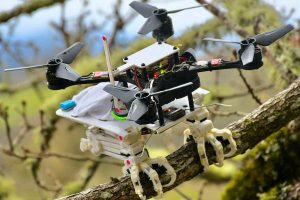Stanford University engineers have created a robot bird that can use its feet to perch and carry things. “It’s not easy to mimic how birds fly and perch,” said Stanford engineer William Roderick. “After millions of years of evolution, they make take-off and landing look so easy, even among all of the complexity and variability of the tree branches you ...
Research
The latest electronics research news from within the industry and universities from around the world.
Copper bonded to PTFE for 5G digital and RF PCBs
Researchers from Osaka University have found a way to bond copper foil to notoriously slippery polytetrafluoroethylene (PTFE). The aim is to improve the bandwidth of PCBs. “Copper is the go-to wiring material for printed wiring boards because it is highly conductive, so the focus for improvement is to decrease transmission loss from the support material,” according to the university, “PTFE ...
Brain chip combines microfluidics and electrodes
Researchers at the Korea Institute of Science and Technology (KIST) have micromachined a multi-functional brain chip with microelectrodes for recording electrical activity, microfluidic channels for sampling extracellular fluid, and a microfluidic interface chip for multiple drug delivery and sample isolation. The cerebrospinal fluid, which is tested for neurotrasmitters, is extracted at a low pressure to minimise channel blockages from prolonged use. It has been tested on ...
Super-squidgy gel is super-tough for soft robotics
The University of Cambridge has developed a squishy jelly with 80% water content that is unfazed by being run over with a car. “At 80% water content, you’d think it would burst apart like a water balloon, but it doesn’t: it stays intact and withstands huge compressive forces,” said Professor Oren Scherman who led the research. “The properties of the ...
Deep red led light exposure in the morning makes your eyes work better for a while
Three minutes of 670nm exposure in the morning appears to make the eyesight of humans over 40 years old better for a week, according to Imperial College London. The improvement is shown in cone-mediated colour contrast thresholds, tested in people from 37 to 70 years old in this research. Improvements have been seen before, using light at ~40mW/cm2, but this work ...
IBM: Compute-in-memory beats GPUs by 10x, sometimes
IBM presented its ultra-low power AI processor at its Zurich technology meeting today. Called Hermes, the core is a scientific demonstrator made on 14nm CMOS that has scored a record energy efficiency of 10.5Top/s/W, plus a density of 1.59Top/s/mm2. The technology is mixed analogue and digital compute-in-memory, using multi-level phase-change memory – the latter added to the CMOS during back-end processing. ...
SiC defect study could improve power bipolar transistors
Silicon carbide mosfets and Schottky diodes are both subject to the unipolar limit – the trade-off between breakdown voltage and specific resistance of the drift layer. Super-junction transistors bypass this limit, and bipolar transistor are not subject to it, but both require p-type semiconductor layers in otherwise n-type unipolar devices. To create p-type SiC, it has to be doped with ...
Heriot-Watt hooks up with Si Catalyst
Silicon Catalyst and Heriot-Watt are collaborating to drive the development and launch of semiconductor companies. They have shared strategic objectives which focus on transforming Scottish-based semiconductor ventures into scale-ups. Through GRID, Heriot-Watt is focused on global research, innovation and discovery. A major focus of GRID is on commercialising high-impact research that delivers economic and social value. Silicon Catalyst has a ...
Triboelectric clothing is breathable for comfort
Electro-spun fibres are a promising candidate for cloth-based tribo-electric nanogenerators (TENGs) according to the University of Fukui. Electro-spinning involves drawing solutions of polymers into fibres using electrical charge. The researchers have developed an all-fibre composite layer TENG that can be integrated with normal cloth. “With our work, we are aiming to provide a new point of view towards wearable energy harvesters ...
Liquid metal pump works by surface tension
A drop of metal that is liquid at just above room temperature can be used as a pump in microfluidics, according to researchers at the University of New South Wales Sydney. Gallium and gallium alloys are suitable. These “are attractive materials due to their unique electrical, thermal and fluidic properties,” according to the university. They “exhibit low melting point, non-toxicity ...
 Electronics Weekly Electronics Design & Components Tech News
Electronics Weekly Electronics Design & Components Tech News









